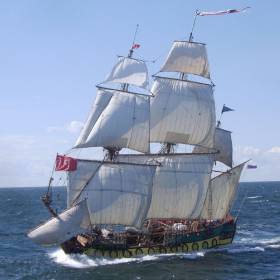Displaying items by tag: The Shtandart
Russian Tall Ship 'Shtandart' Among a New Fleet Visiting Drogheda Port for the Irish Maritime Festival
Drogheda Port's Captain Martin Donnelly have invited a wonderful new fleet of ships to visit Drogheda for the Irish Maritime Festival 2017 on 10-11th June.
“The visiting ships are the focal point of The Irish Maritime Festival and it is always wonderful to see people of all ages climbing aboard to explore these magnificent vessels. It’s so important that we offer a selection of ships each year to interest and excite our audience and this is our biggest offering of Tall Ships yet.” explains Capt. Donnelly, Harbourmaster of Drogheda Port.
He was speaking this week as he unveiled the line-up of ships visiting Drogheda this year.
“We’re delighted to welcome the Brian Boru, a sail training vessel based in Waterford. Drogheda’s first crew of sail trainees will arrive at the end of their voyage on Friday while the second crew will depart Drogheda on Monday.”
Perhaps the most impressing of all the ships sailing into Drogheda this summer will be the “Shtandart”. Commissioned by Tsar Peter I of Russia in 1703, the modern day “Shtandart” is an exact replica. Built in 1999, this magnificent 128m long vessel carries 10 officers and 30 trainees. The elegant masts will play host to the Peter Pan aerial acrobatic show during the Irish Maritime Festival.
He continued “We’ve an unusual new addition to the festival for 2017. Coming into service in 1965, the motor tug “Brocklebank” served for 23 years as a tug assisting cargo ships, passenger liners and naval vessels to their berths. She really has been a workhorse of the maritime industry. Now, in retirement, she resides at Albert Dock as part of the Liverpool Maritime Museum and we’re delighted that she’s making the journey to Drogheda for the festival.”
Captain Donnelly concluded “Others visiting Drogheda for the festival include “La Malouine”, an elegant Polish brigantine, the Danish schooner “Soteria” and the stunning “Phoenix”. “The Earl of Pembroke” a magnificent three-masted sailing ship will also dock at Drogheda Port and play host to the Stowaway Sessions, two intimate music gigs on Friday and Saturday night.”
Keep your eye out for the beautiful tall sailing ship “Maybe”, which was built in 1929, which will make a short appearance with another crew of sail trainees. This year there is a big focus on sail training at the festival with no less than three vessels carrying trainees. A special gathering and presentation is taking place at 6.00pm on Friday 9th June at Millmount Tower. Anyone interested in future voyages is welcome to attend.
Find out more about each of the ships by visiting www.MaritimeFestival.ie/Ships. The Irish Maritime Festival is hosted by Louth County Council and Drogheda Port Company in association with Virgin Media. Find out more by visiting www.MaritimeFestival.ie and follow on Facebook and Twitter for competitions, news and festival updates.























